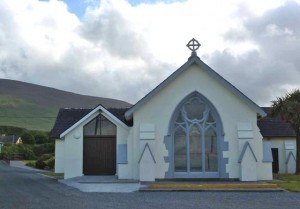Today in Irish History, Roundup at Midnight Mass, 24 December 1922

A short seasonal tale of the Irish Civil War in Kerry. By John Dorney.
Curragheen, County Kerry, Christmas Eve, 1922. Twenty two guerrillas of the IRA came down from their winter dugouts in the hills into the village. They piled their arms outside the village Catholic Church and filed inside to Christmas Midnight Mass.
They were, no doubt, dirty and scruffy from living rough and avoiding Free State patrols. They would have worn their own clothes, many perhaps with the trademark IRA gear of peaked cap and trench coat. Many would also have worn bandoliers of ammunition across their chests.
No doubt they expected a rough time when the sermon came around.
On 10 October, the Catholic Bishops of Ireland had issued a formal statement, describing the anti-treaty campaign as,
a system of murder and assassination of the National forces without any legitimate authority… the guerrilla warfare now being carried on by the Irregulars is without moral sanction and therefore the killing of National soldiers is murder before God, the seizing of public and private property is robbery, the breaking of roads, bridges and railways is criminal. All who in contravention of this teaching, participate in such crimes are guilty of grievous sins and may not be absolved in Confession nor admitted to the Holy Communion if they persist in such evil courses.[1]
The relationship of Irish republicans with the Catholic Church had always been complicated. As far back as the Fenians of the 1860s, the Church had been against revolutionary violence and suspicious of republicanism, associated as it was in continental Europe with anti-clericalism.
The relationship of Irish republicans and the Catholic Church had always been complicated, in the civil war it turned into direct confrontation
But the vast majority of republican activists and especially the anti-Treaty guerrillas in rural Kerry, were practising Catholics, which was what brought the column to mass at Curragheen that Christmas.
During the war against the British in 1919-1921, the Church had been divided by the IRA’s campaign.
In Kerry in 1921, a local intelligence IRA officer, Tim Kennedy was confronted with allegations that a local Catholic priest, E.H. Collins, a British Army chaplain of the Dominican Order, had reported the pro-IRA remarks of a local woman to the Black and Tans, who went on to blow up her house and family business.
In any other case, in the time and place, the IRA would have shot the man. But shooting priests was a perilous business. Kennedy was put in touch with Finbar Ryan, the superior of the Dominican Order in Ireland, who told him, “this is no priest of God. Do your duty boy and have no fear of the future”. Kennedy would not be moved however, “I would submit myself to be put against the wall myself before I would do my ‘duty’ on a priest, no matter how bad he was”. Father Collins was eventually transferred out of Tralee instead. [2]
The Republicans and the Church might at times be rivals for the same public, but they seemed to feel they could not truly be enemies. During the civil war though, the contradictions between loyalty to the Church and to the Republic became more intense. The Church and its clergy were openly on the pro-Treaty side and actively opposed the anti-Treaty Republicans.
In Kerry on December 15, about 70 Anti-Treaty IRA fighters laid an ambush for a Free State patrol between Rathmore and Barraduff. The local priest, a Father Carmody, assembled a large number of his parishioners to remove the trees the IRA had laid as a roadblock. The traditional subservience to priests was not for Soldiers of the Republic though. The guerrillas dispersed the crowd by firing over their heads and seized four of the priest’s fat bullocks as a punishment. Three National Army troops were wounded in the ensuing ambush, one fatally. [3]
The ‘Irregulars’ were sitting in Church, their arms piled outside but the priest had alerted theFree State garrison in nearby Tralee to the presence of the guerrilla column
And so to Curragheen on 24 December, with the ‘Irregulars’ sitting in Church, their arms piled outside. The priest however, had alerted the Free State garrison in nearby Tralee to the presence of the guerrilla column at Midnight Mass.
At some point in the service, a lorry of National Army troops pulled up outside, fully armed. Pandemonium must have ensued as the anti-Treatyites were arrested. Some no doubt, tried to reach their weapons outside. Others must have tried to escape out of side doors. Seven were captured hiding under the altar For the locals it must have been bewildering and terrifying.
In total 22 of the IRA men were captured when National Army troops raided the church.[4]
The little story had echoes all over Ireland. Current Irish president Michael D Higgins has spoken of how his own father, also an IRA fighter in the civil war was led away to captivity under the supervision and curses of the local priest.
In the new Ireland in 1922-23 and for many decades afterwards, there would be no challenging Mother Church.